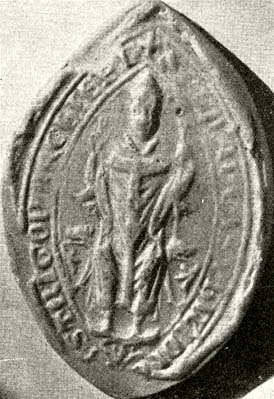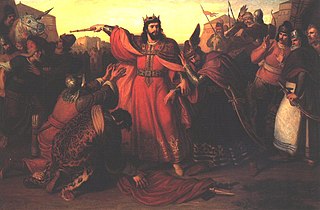Related Research Articles
Matthias from the kindred Rátót was a Hungarian prelate in the first half of the 13th century, who served as Bishop of Vác from 1238 to 1240, then Archbishop of Esztergom from 1239 until his death in the Battle of Mohi. He was the first Archbishop of Esztergom, who was referred to as Primate of Hungary.
Fancica or Francica was a Hungarian prelate at the turn of the 11th and 12th centuries, who served as Bishop of Zagreb from around 1125 to 1131, then Archbishop of Kalocsa from 1131 until his death.
Kalán from the kindred Bár-Kalán was a prelate and royal official in the Kingdom of Hungary at the turn of the 12th and 13th centuries. He was bishop of Pécs from 1186 until his death in 1218, and ban of Croatia and Dalmatia between 1193 and 1194, thus he was the first prelate in the kingdom to parallelly held a secular office. Kalán's relationship with the monarch was tense in the reign of King Emeric who accused the bishop of incest but could never prove it. Although a part of the canons of Esztergom elected Kalán as archbishop in 1204, his election was not confirmed by the Holy See. Kalán died when planning to go on a crusade to the Holy Land.

John was a prelate in the Kingdom of Hungary in the 12th and 13th centuries. He was Bishop of Csanád between 1198 and 1201, Archbishop of Kalocsa from 1202 to 1205 and Archbishop of Esztergom between 1205 and 1223. He crowned Ladislaus III of Hungary, Andrew II of Hungary and Coloman of Halych king. Andrew II appointed him to govern the kingdom during his crusade between 1217 and 1218.
Boleslaus was a prelate in the Kingdom of Hungary at the turn of the 12th and 13th centuries. He was Bishop of Vác between 1193 and 1212. He supported Duke Andrew during the Duke's conflict with his brother, King Emeric of Hungary.
Mog, also Moch, Magh or Mok was a powerful Hungarian lord in the Kingdom of Hungary at the turn of the 12th and 13th centuries, who served as Palatine of Hungary three times.
Mika (I) from the kindred Ják was a Hungarian influential lord in the Kingdom of Hungary at the turn of the 12th and 13th centuries.
Ugrin from the kindred Csák was a Hungarian prelate at the turn of the 12th and 13th centuries, who served as Bishop of Győr from 1188 to 1204, then briefly Archbishop-elect of Esztergom in 1204.
Timothy was a prelate in the 13th century, who served as Bishop of Zagreb from 1263 until his death.
Desiderius was a prelate in the Kingdom of Hungary in the 12th and 13th centuries, who served as Bishop of Csanád between 1202 and 1228. Before that he functioned as chancellor in the royal court of King Emeric.
Saul from the kindred Győr was a prelate in the Kingdom of Hungary at the turn of the 12th and 13th centuries. He was Bishop of Csanád between 1188 and 1192, then Archbishop of Kalocsa from 1192 until his death.

Philip from the kindred Türje, also known as, albeit incorrectly, Philip of Szentgrót was a Hungarian prelate in the 13th century, who served as Bishop of Zagreb from 1247 or 1248 to 1262, and as Archbishop of Esztergom from 1262 until his death.
Henry (II) Kőszegi was a Hungarian influential lord at the turn of the 13th and 14th centuries. He was a member of the powerful Kőszegi family. He extended his influence over Upper Slavonia since the 1280s, becoming one of the so-called "oligarchs", who ruled their dominion de facto independently of the monarch. After the extinction of the House of Árpád, he participated in the dynastic struggles. He drew Southern Transdanubia under his suzerainty by then.
Peter was a Hungarian prelate at the turn of the 12th and 13th centuries, who served as Bishop of Győr from 1205 to 1218. Prior to that, he was chancellor in the royal court of Emeric, King of Hungary between 1202 and 1204. He participated in the Fifth Crusade, where he was killed in fights against the Ayyubid Sultanate. Some historians identify him with the chronicler Anonymus, author of the Gesta Hungarorum.

Stephen II was a Croatian–Hungarian prelate of the Catholic Church who served as Bishop of Zagreb from 1225 until his death in 1247.
Benedict was a Hungarian lord at the turn of the 12th and 13th centuries, who served as Ban of Slavonia from 1199 to 1200 and as Palatine of Hungary from 1202 to 1204. He was a staunch supporter of Emeric, King of Hungary.

The Brothers' Quarrel was a war of succession within the Árpád dynasty between Emeric, the King of Hungary, and his younger brother, Andrew, Duke of Slavonia. It lasted from 1197 to 1203, covering almost the entire reign of Emeric. The conflict had a significant impact on the development of the 13th-century society and political system in the Kingdom of Hungary.
Andrew was a Hungarian lord at the end of the 12th century, who – as a confidant of the rebellious Duke Andrew – served as Ban of Slavonia. Through his marriage, he was son-in-law of the late King Géza II of Hungary.
Elvin was a Hungarian prelate in the late 12th century, who served as Bishop of Várad from 1189 to 1200.
John was a Hungarian Catholic prelate in the 13th century, who served as Bishop of Nyitra at least from 1204 to 1221.
References
- 1 2 Zsoldos 2011, p. 102.
- ↑ Dobronić 1995, p. 29.
- ↑ Szeberényi 2003, pp. 161–162.
- 1 2 Szabados 1999, p. 105.
- ↑ Szeberényi 2003, pp. 163–164.
- ↑ Szabados 1999, p. 100.
- ↑ Szeberényi 2003, p. 165.
- ↑ Szeberényi 2003, pp. 166–168.